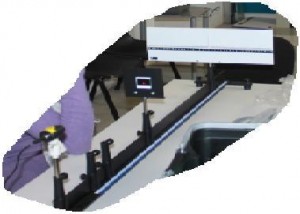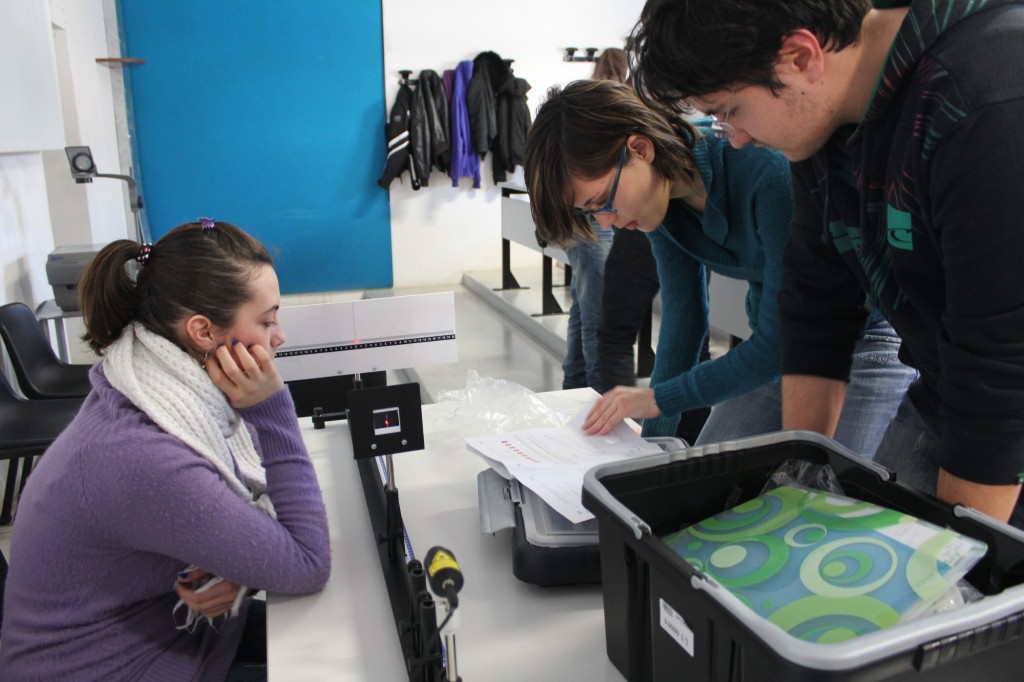Activities carried out during the period September 2011-February 2012 on optical bench
The theoretical study
The group, following the acquisition of the optical bench, he could start a series of experiments concerning the phenomena of geometrical optics and wave optics. Initially two lessons have been addressed in theoretical physics, in which the group has learned the main characteristics of the light, in particular, they discussed the two aspects, corpuscular or wave, that light can take, citing the photoelectric experiment carried out by Einstein, resumed his discussion that the nature of light and which led to the conclusion that the light in certain situations it behaves as a wave, in other as a set of particles (called “photons”). After this brief introduction, have been addressed the basic characteristics of the wave, or the length, the width, the speed of propagation, the period and frequency, and we have tried to give a coherent definition of the phenomenon “wave”: a ‘oscillation that propagates in space transporting energy, but not matter, then in distinguishing mechanical waves, which require a means of propagation, and electromagnetic, that can propagate in a vacuum, was carried out, in addition, a differentiation depending on the direction vibration in transverse and longitudinal waves.
The experiments of the geometrical optics
The first experiments carried out are related to geometrical optics, for example,  the first two addressed concerned the properties of light to propagate in a straight line, a property which has been verified through some calculations and has been observed in a reproduction of the Sun-Earth system. Later experiments were carried out on the properties of light, such as the diffusion and radiation, and has been addressed a brief discussion of the speed of light, deepening the historical journey of discovery, from the failed attempt to Galileo, passing through estimates of Rømer and Fizeau, and then finally arrive in the experiment of Foucault, who improved the method of Fizeau failing to give an estimate a more accurate estimate. The largest section of the part of geometrical optics consists of the phenomena of reflection, refraction and total internal reflection, the reflection has been carried out an experiment (No. 5 of the manual of the optical bench), with an explanation of the laws of reflection. Before carrying out the experiments on the refraction and total internal reflection (respectively No. 8 and No. 9) was necessary to introduce some elements of trigonometry, to make understandable the formulas of the two phenomena to all members of the group. After the measurements were carried out to confirm the concepts learned through theory and, on the refraction, has deepened the phenomenon of light scattering, by performing some experiments with the aid of a glass prism. The last part of the study of geometrical optics for the lenses and mirrors, and after a brief explanation on the different characteristics of convergent and divergent lens, have faced two experiments, in ° 12 and 13, to observe the properties of these lenses and and, through the experiment No. 14, has studied the functioning of the human eye, especially the lens (which works just like a converging lens), and defects (myopia and presbyopia). As for the mirrors, the group has studied the properties of flat mirrors, with a short digression on the work of last year (the kaleidoscope) of parabolic mirrors and spherical mirrors, which were divided into concave and convex mirrors. Thanks experiment No. 7, were observed the characteristics of these two types of mirror, in relation to the distance between the mirror and the reflected image, coming to determine the formula of the law of conjugate points.
the first two addressed concerned the properties of light to propagate in a straight line, a property which has been verified through some calculations and has been observed in a reproduction of the Sun-Earth system. Later experiments were carried out on the properties of light, such as the diffusion and radiation, and has been addressed a brief discussion of the speed of light, deepening the historical journey of discovery, from the failed attempt to Galileo, passing through estimates of Rømer and Fizeau, and then finally arrive in the experiment of Foucault, who improved the method of Fizeau failing to give an estimate a more accurate estimate. The largest section of the part of geometrical optics consists of the phenomena of reflection, refraction and total internal reflection, the reflection has been carried out an experiment (No. 5 of the manual of the optical bench), with an explanation of the laws of reflection. Before carrying out the experiments on the refraction and total internal reflection (respectively No. 8 and No. 9) was necessary to introduce some elements of trigonometry, to make understandable the formulas of the two phenomena to all members of the group. After the measurements were carried out to confirm the concepts learned through theory and, on the refraction, has deepened the phenomenon of light scattering, by performing some experiments with the aid of a glass prism. The last part of the study of geometrical optics for the lenses and mirrors, and after a brief explanation on the different characteristics of convergent and divergent lens, have faced two experiments, in ° 12 and 13, to observe the properties of these lenses and and, through the experiment No. 14, has studied the functioning of the human eye, especially the lens (which works just like a converging lens), and defects (myopia and presbyopia). As for the mirrors, the group has studied the properties of flat mirrors, with a short digression on the work of last year (the kaleidoscope) of parabolic mirrors and spherical mirrors, which were divided into concave and convex mirrors. Thanks experiment No. 7, were observed the characteristics of these two types of mirror, in relation to the distance between the mirror and the reflected image, coming to determine the formula of the law of conjugate points.
The experiments of wave optics
Before the start of wave optics was carried out a brief review of the  characteristics of the waves and was made a study of the diode laser to better understand its operation (it was therefore necessary to clarify the quantized orbits and on the behavior of electrons excited), and to do that, the group is based on information found in the manual of the optical bench and on the Internet. The first experiment of wave optics (No. 20 of the manual) is carried out on the interference, of which the first was made a theoretical introduction, presenting the difference between destructive interference and constructive, and then proceed with the actual experiment , which follows the one made in 1801 by Thomas Young and expects the interference through two slits. The measurements were performed with both the laser optical bench and there is a difference of wavelength, in fact the data obtained were used to calculate the wavelength of the two lasers, and the results were compared with those of ‘experiment n ° 19, which included the measurement of the wavelength through another method.
characteristics of the waves and was made a study of the diode laser to better understand its operation (it was therefore necessary to clarify the quantized orbits and on the behavior of electrons excited), and to do that, the group is based on information found in the manual of the optical bench and on the Internet. The first experiment of wave optics (No. 20 of the manual) is carried out on the interference, of which the first was made a theoretical introduction, presenting the difference between destructive interference and constructive, and then proceed with the actual experiment , which follows the one made in 1801 by Thomas Young and expects the interference through two slits. The measurements were performed with both the laser optical bench and there is a difference of wavelength, in fact the data obtained were used to calculate the wavelength of the two lasers, and the results were compared with those of ‘experiment n ° 19, which included the measurement of the wavelength through another method.
Future projects
To date, the group has dealt with these issues, the next object of study is the phenomenon of diffraction (with a study of the diffraction grating), followed by a brief introduction to spectroscopy and an interesting study on the polarization of light. With these experiments it is concluded that the program of the optics group, which is considering continuing his work with the construction of some optical devices, such as a camera or microscope, or the construction of an interferometer (as has been suggested by Professor Ferrari), but the issue is still under discussion and the group did not reach a single decision


Leave a reply
You must be logged in to post a comment.